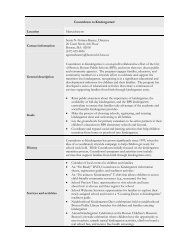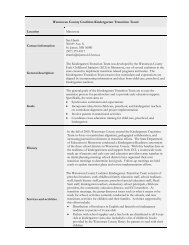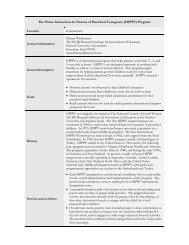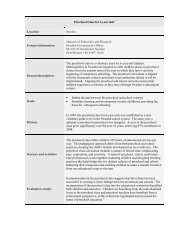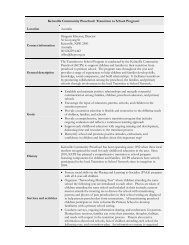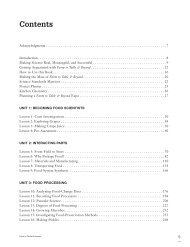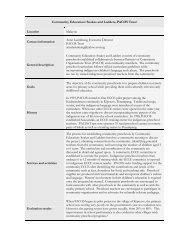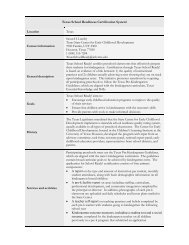Proceedings of the Fourth Annual Teachers College Educational ...
Proceedings of the Fourth Annual Teachers College Educational ...
Proceedings of the Fourth Annual Teachers College Educational ...
You also want an ePaper? Increase the reach of your titles
YUMPU automatically turns print PDFs into web optimized ePapers that Google loves.
iPad for Autism: How can <strong>the</strong> iPad serve as a teaching tool for<br />
students on <strong>the</strong> Autism Spectrum?<br />
Sheena S. Mozaffar,<br />
<strong>Teachers</strong> <strong>College</strong>, Columbia University, 105, Christopher Street Apt. 2A, New York, NY 10014,<br />
Email: ssm2173@tc.columbia.edu<br />
Abstract: The purpose <strong>of</strong> this research was to explore <strong>the</strong> use <strong>of</strong> iPad technology in a 1 st<br />
grade self-contained classroom with students suspected to be on <strong>the</strong> Autism Spectrum.<br />
According to a 2012 estimate <strong>the</strong> Center for Disease Control and Prevention, 1 out <strong>of</strong><br />
every 88 children in <strong>the</strong> US is diagnosed with an Autism Spectrum Disorder and <strong>the</strong> rate<br />
has increased by 23% since 2009. Hence, <strong>the</strong>re will be a rise in <strong>the</strong> number <strong>of</strong> students<br />
on <strong>the</strong> spectrum within tomorrow’s classrooms. It is necessary to identify how technology<br />
can support <strong>the</strong> teacher <strong>of</strong> tomorrow to accomplish learning objectives. This research<br />
was aimed towards identifying <strong>the</strong> impact <strong>of</strong> touch-screen technology, like <strong>the</strong> iPad, on<br />
students displaying autistic tendencies. The process began with isolating a focus group <strong>of</strong><br />
four students on <strong>the</strong> spectrum. I videotaped classroom observations on individual student<br />
interactions with <strong>the</strong> iPad to observe engagement, manipulation and functionality with <strong>the</strong><br />
hardware and s<strong>of</strong>tware. Then I recorded student interactions, in groups <strong>of</strong> 2 and 4,<br />
sharing <strong>the</strong> iPad to examine social interaction and communication. This was followed by<br />
conducting a Math activity using concrete materials and replicating <strong>the</strong> activity with an<br />
iPad App to study <strong>the</strong> difference in engagement, interaction and instruction. Students<br />
were introduced to a new App to analyze change in level <strong>of</strong> engagement compared to<br />
working with Apps <strong>the</strong>y knew well from experience. The research also draws upon<br />
interviews I conducted with teachers, speech and occupational <strong>the</strong>rapists, and assistive<br />
technology specialists to expand upon <strong>the</strong> iPad’s capability as both a teaching tool and<br />
assistive device. As a result <strong>of</strong> this research I learnt that <strong>the</strong> iPad cannot be utilized with<br />
every child on <strong>the</strong> Autism Spectrum. <strong>Teachers</strong> have to adapt <strong>the</strong>ir lesson and use <strong>of</strong> <strong>the</strong><br />
iPad, through physical device manipulation or App usage, to support student needs in<br />
terms <strong>of</strong> comfort with abstract learning and unstructured/structured activity engagement.<br />
iPad usage with students must be supervised to ensure educational exposure and device<br />
safety. The iPad can be used as an incentive, for self-reinforcement <strong>of</strong> subject matter,<br />
student assessment and lesson differentiation by using specific Apps. The iPad was able<br />
to aid students on <strong>the</strong> spectrum to self-regulate, perform turn-taking, peer mentoring and<br />
communicate physically as well as verbally with each o<strong>the</strong>r. The iPad’s accessibility<br />
features, mobility and media integration made it easier for <strong>the</strong> teacher and students to<br />
access multiple forms <strong>of</strong> media to support lessons.<br />
References<br />
Autism Speaks Inc., (2012). What is Autism? What is Autism Spectrum Disorder? Retrieved from:<br />
http://www.autismspeaks.org/what-autism<br />
Barnes, E. B., O’Flynn, J., Saile, L., (2008). Families, Infants and Young Children at Risk:<br />
Pathways to Best Practice. Baltimore, MD: Paul H Brookes Pub Co.<br />
Brandon, J., (2011, Mar 9). Is <strong>the</strong> iPad a ‘Miracle Device’ for Autism? Retrieved from:<br />
http://www.foxnews.com/scitech/2011/03/09/can-apple-ipad-cure-autism/<br />
Center for Disease Control and Prevention, (2012). New Data on Autism Spectrum Disorders.<br />
Retrieved from: http://www.cdc.gov/Features/CountingAutism/<br />
CBC News, (2011, Oct 25). iPad helps Toronto special needs kids learn. Retrieved from:<br />
http://www.cbc.ca/news/health/story/2011/10/25/ipad-autism.html<br />
Dana, N. F., Yendel-Hoppey, D., (2009). The Reflective Educator’s Guide to Classroom Research:<br />
Learning to Teach and Teaching to Learn through Practitioner Inquiry. Thousand Oaks, CA:<br />
Corwin Press<br />
Darragh, J., (2007). Universal Design for Early Childhood Education: Ensuring Access and Equity<br />
for All. Early Childhood Education Journal, 35(2), 167-171<br />
49



